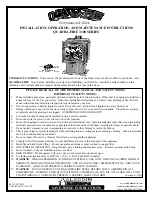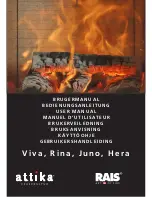
5
FDCiT
Is
sue 03 10/14
If you have any doubts about the suitability of your chimney, consult your local
dealer/stockist or chimney specialist. If there is no existing chimney then either a solid
fuel compatible prefabricated block chimney or a twin-walled insulated stainless steel
flue to BS 1856 can be used. These chimneys must be fitted in accordance with the
manufacturer’s instructions and Building Regulations.
4.2 Ventilation
Purpose provided ventilation is not required in England and Wales unless the appliance
nominal rated output is greater than 5kW. Over 5kW 5.5 cm
2
of ventilation (550mm
2
) is
required for every kW output above 5. For example 6.5 kW requires 8.25 cm
2
and 8 kW
needs 16.5cm
2
. In any case, if difficulty in starting the fire or any fuming is experienced,
ventilation must be put in place as required to eliminate these flue problems. If a flue
draught stabiliser is fitted then extra ventilation is required. See Document J of the
Building Regulations for detailed guidance especially in new build properties. See
VENTILATION in INSTALLATION section.
4.3 Flue Draught
A flue draught of minimum 1.2mm to a maximum 2.5mm water gauge (12 to 25 Pascals)
is required for satisfactory appliance performance. The flue draught should be checked
under fire at high output and, if it exceeds the recommended maximum, a draught
stabiliser must be fitted so that the rate of burning can be controlled to prevent over-
firing.
4.4 Connection to the Chimney
This appliance is
not
suitable for use in a shared flue.
A flue liner may be used although is not required for operation of the stove. A sound and
safe brick or clay lined chimney is acceptable. A reputable registered and experienced
installer will advise. All installations must comply with Building Regulations.
An existing fireplace opening can be bricked up or sealed with a register plate. A short
length of flue pipe of a minimum 125mm internal diameter (150mm min where the flue
spigot socket is 150mm diameter) may then be used to connect the stove to the
chimney or flue liner. A maximum of 150mm horizontal flue pipe can be used. This flue
pipe should conform to Building Regulations. The stove should be insulated and
properly fitted into the fireplace opening by back filling with 6:1 ratio vermiculite &
cement mixture using minimal water through the top of the fireplace or flue spigot
opening. The surface should be finished using 1:1:8 mix of cement, lime and sand. Any
connecting pipe can be fitted and the spigot pushed up from inside the stove and rotated
onto its keyhole slots to join to the pipe. Ensure that the pipe end is no closer than
76mm to the side or rear chimney walls. Ideally, the old fireplace should be filled in so
that there is a smooth streamlined entry into the flue way. It is essential that all
connections between the stove and chimney-flue are sealed and made airtight with
sealing rope, clamping rings and/or fire cement or heat resisting cement where required.
Both the chimney and flue pipe must be accessible for cleaning and if ANY parts of the
chimney cannot be reached through the stove (with baffle removed), a soot door must
be fitted in a suitable position to enable this to be done.
4.5 Fixing
Fix the stove to the back hearth using suitable non-combustible fixings through the base
of the outer firebox. If necessary screw the outer firebox to the back-panel by fixing the
top or sides of the firebox using suitable non-combustible fixings.
Содержание 5i Taper
Страница 16: ...15 FDCiT Issue 03 10 14 8 0 FDC 5i Taper Stove Dimensions...
Страница 17: ...16 FDCiT Issue 03 10 14 Blank Page...
Страница 18: ...17 FDCiT Issue 03 10 14 Blank Page...
Страница 19: ...18 FDCiT Issue 03 10 14 Blank Page...






































